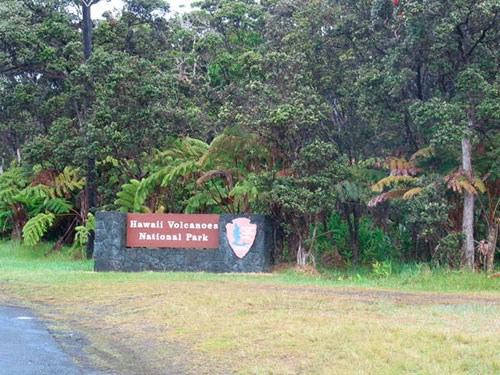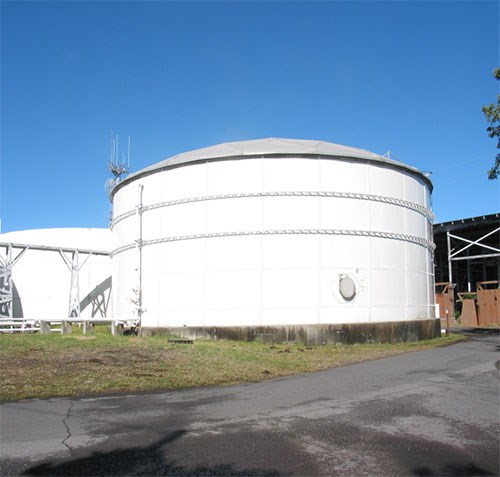|
What is the source of my water? Our sole source of drinking water at Hawai‘i Volcanoes National Park (HAVO) is from rain. Our water system collects treats and stores rain water for public consumption. Sodium Carbonate is added to the water to reduce the acidity. The water is processed through three Slow Sand Filters. Zinc-Ortho-Phosphate is added for corrosion control and Sodium Hypochlorite is added for disinfection to make it safe for consumption. 
All drinking water, including bottled water, may reasonably be expected to contain at least small amounts of some contaminants. The presence of contaminants does not necessarily indicate that water poses a health risk. More information about contaminants and potential health effects can be obtained by calling the Environmental Protection Agency’s (EPA) Safe Drinking Water Hotline. (1-800-426-4791). Kīlauea Incident The water system was offline between May 17, 2018 and September 21, 2018. The numerous earthquakes during the eruption caused enough damage to the water system infrastructure that the entire system was shutdown, repairs were made, water testing was preformed and the system was returned to active status on September 21, 2018. What are some drinking water contaminants? The sources of drinking water (both tap and bottled water) include rivers, lakes, streams, ponds, reservoirs, springs, and wells. As water travels over the surface of the land or through the ground, it dissolves naturally occurring minerals and can pick up substances resulting from the presence of animals or from human activity. Contaminants that may be present in various source water include: - Microbial contaminants, such as viruses and bacteria, which may come from sewage treatment plants, septic systems, agricultural livestock operations and wildlife. - Inorganic contaminants, such as salts and metals, which can be naturally occurring or result from urban storm water runoff, industrial or domestic wastewater discharges, oil and gas production, mining or farming. - Pesticides and herbicides, which can come from a variety of sources such as agriculture, urban storm water runoff and residential uses. - Organic chemical contaminants, including synthetic and volatile organic chemicals, which are by-products of industrial processes and petroleum production, and can also come from gas stations, urban storm water runoff, and septic systems. - Radioactive contaminants, which can be naturally-occurring or be the result of oil and gas production and mining activities. - Acid Rain, usually caused by sulfur dioxide. Natural sources include; volcanoes, sea spray and rotting vegetation. Is our water system meeting other rules that govern our operations? The State and Environmental Protection Agency (EPA) require us to test our water on a regular basis to ensure its safety. In order to ensure tap water is safe to drink, EPA prescribes regulations which limit the amount of certain contaminants in water provided by public water systems. FDA regulations establish limits for contaminants in bottled water which must provide the same protection for public health. 
Do I need to take special precautions? Some people may be more vulnerable to contaminants in drinking water than the general population. Immune-compromised persons such as persons with cancer undergoing chemotherapy, persons who have undergone organ transplants, people with HIV/AIDS or other immune system disorders, some elderly, and infants can be particularly at risk from infections. These people should seek advice about drinking water from their health care providers. EPA/CDC guidelines on appropriate means to lessen the risk of infection by Cryptosporidium and other microbial contaminants are available from the EPA Safe Drinking Water Hotline – (808-426-4791). Important Definitions MCL - Maximum Contaminant Level - The highest level of a contaminant that is allowed in drinking water, MCL’s are set as close to the MCLG as feasible using the best available treatment technology. 
AL - Action Level - The concentration of a contaminant which, if exceeded, triggers treatment or other requirements which a water system must follow. ppm - part per million - One part per million is about 1/2 of a dissolved aspirin in a full bathtub of water (about 50 gallons). ppb – part per billion - One part per billion is about one dissolved aspirin tablet in a typical 25-meter swimming pool (about 100,000 gallons). N/A Non-Applicable ND Not Detected Water Quality Monitoring Results The Environmental Protection Agency and State Department of Health require that water systems test for contaminants and report all contaminants. The EPA allows us to monitor for some contaminants less than once per year because the concentrations of those contaminants do not vary significantly from year to year, or our system is not considered vulnerable. HAVO's water system meets or exceeds the federal and state drinking water standards. The following tables contain information on trace amounts of contaminants detected.

Lead and Copper Our water system results do not exceed the lead and copper action levels and the system has satisfactorily completed three years of monitoring and was allowed to reduce the frequency of monitoring to once every three years. The table below represents the 90th percentile results of lead and copper testing from 2018 in the HAVO water supply. Copper & Lead Contaminants Results HAVO Water
If present, elevated levels of lead can cause serious health problems, especially for pregnant women and young children. Lead in drinking water is primarily from materials and components associated with service lines and home plumbing. HAVO is responsible for providing high quality drinking water, but cannot control the variety of materials used in plumbing components. When your water has been sitting for several hours, you can minimize the potential for lead exposure by flushing your tap for 30 seconds to 2 minutes before using water for drinking or cooking. If you are concerned about lead in your water, you may wish to have your water tested. Information on lead in drinking water, testing methods, and steps you can take to minimize exposure is available from the EPA Safe Drinking Water Hotline at 1-800-426-4791, or at http://www.epa.gov/safewater/lead
Any questions about this report or our water system can be directed to Jon Christensen, Facility Manager, at (808) 985-6055 or Jack Osburn WTPO/DSO at (808) 985-6066. 
|
Last updated: March 11, 2019
